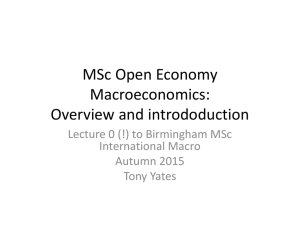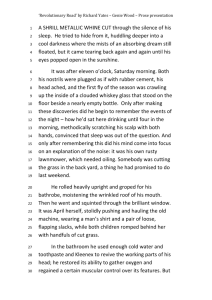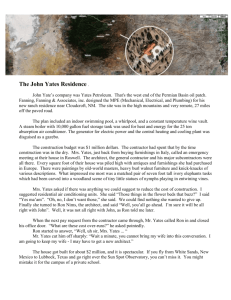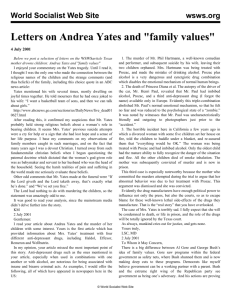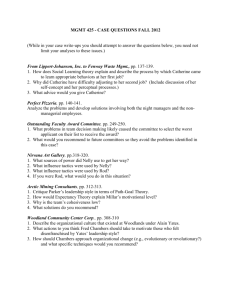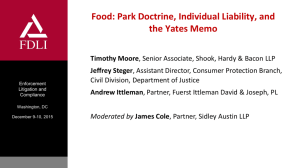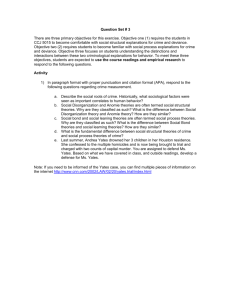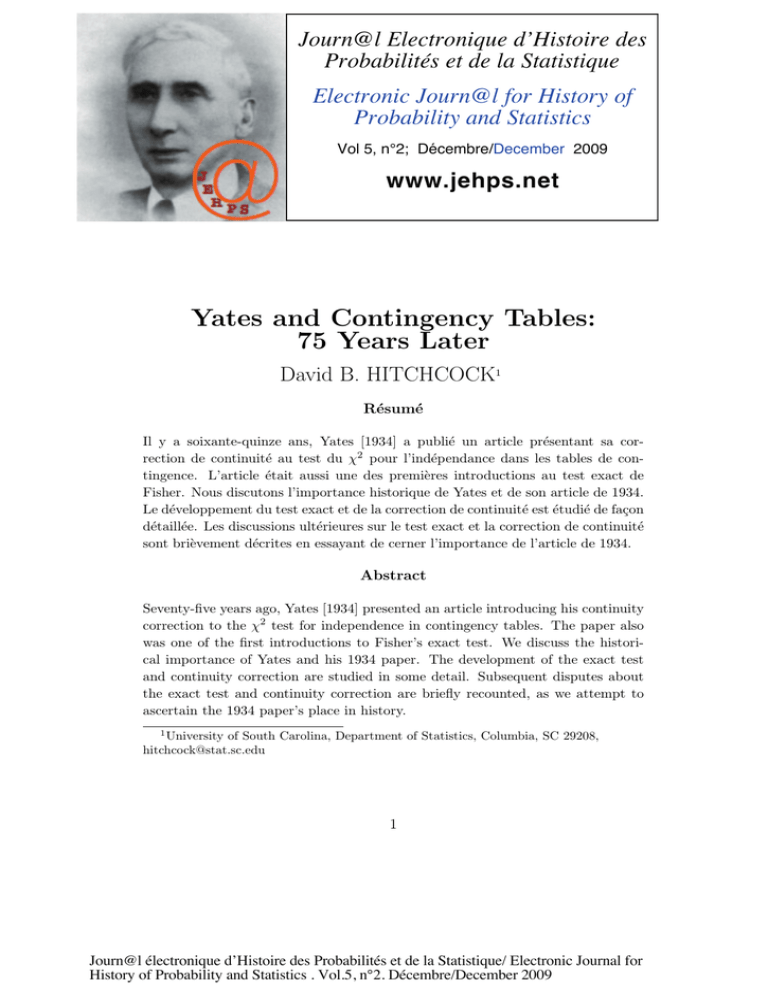
Journ@l Electronique d’Histoire des
Probabilités et de la Statistique
Electronic Journ@l for History of
Probability and Statistics
Vol 5, n°2; Décembre/December 2009
�������������
Yates and Contingency Tables:
75 Years Later
David B. HITCHCOCK1
Résumé
Il y a soixante-quinze ans, Yates [1934] a publié un article présentant sa correction de continuité au test du χ2 pour l’indépendance dans les tables de contingence. L’article était aussi une des premières introductions au test exact de
Fisher. Nous discutons l’importance historique de Yates et de son article de 1934.
Le développement du test exact et de la correction de continuité est étudié de façon
détaillée. Les discussions ultérieures sur le test exact et la correction de continuité
sont brièvement décrites en essayant de cerner l’importance de l’article de 1934.
Abstract
Seventy-five years ago, Yates [1934] presented an article introducing his continuity
correction to the χ2 test for independence in contingency tables. The paper also
was one of the first introductions to Fisher’s exact test. We discuss the historical importance of Yates and his 1934 paper. The development of the exact test
and continuity correction are studied in some detail. Subsequent disputes about
the exact test and continuity correction are briefly recounted, as we attempt to
ascertain the 1934 paper’s place in history.
University of South Carolina, Department of Statistics, Columbia, SC 29208,
hitchcock@stat.sc.edu
1
1
Journ@l électronique d’Histoire des Probabilités et de la Statistique/ Electronic Journal for
History of Probability and Statistics . Vol.5, n°2. Décembre/December 2009
1
Introduction
The year 2009 marks the 75th anniversary of the publication of Frank Yates’
paper [Yates 1934] discussing options for testing for association in contingency tables: the Pearson χ2 test, Fisher’s exact test, and the well-known
continuity correction that bears Yates’ name. While it may not be commonly
given credit as a colossally influential article that has shaped statistical science, this medium-length paper introduced some lasting ideas and methods
(as well as some perpetually controversial ones) to contingency table analysis.
The purpose of Yates’ paper is twofold: firstly, to introduce statisticians
to Fisher’s exact test (a very new procedure at the time), in large part to
use the exact test as a sort of gold standard against which the small-sample
performance of the (at that point in time) well-established χ2 test of Pearson
may be judged. Secondly, Yates presents his continuity correction, which
results in the χ2 test better approximating the exact test.
Yates [1934] motivates the discussion by immediately asserting, “The χ2
test is admittedly approximate, for in order to establish the test it is necessary
to regard each cell value [i.e., count] as normally distributed with a variance
equal to the expected value, the whole set of values being subject to certain
restrictions.” Note that the variance equals the mean in the archetypal count
model, the Poisson, and that the normal approximates a Poisson with large
mean. This heuristic argument was also used by Fisher in a revised footnote
within a paper on the χ2 statistic [Fisher 1922].
Of course, the χ2 approximation requires a large sample size, and Yates
quotes the rule of thumb that is still most commonly used today: the χ2
test is “sufficiently accurate if no cell has an expectancy of less than 5.” In
Section 5 we deal with Yates’ discussion of the performance of the χ2 test for
small to moderate samples.
After some brief background information about Frank Yates, we explore
in Sections 3 through 5 his 1934 paper, outlining its major statistical contributions. In Section 6 we briefly discuss controversies and criticisms of Yates’
correction that arose in later years and revisit Yates’ 1984 reply to those
critics. The final section details the historical importance of the 1934 paper.
2
Journ@l électronique d’Histoire des Probabilités et de la Statistique/ Electronic Journal for
History of Probability and Statistics . Vol.5, n°2. Décembre/December 2009
2
Background information about Frank Yates
There are a number of good biographical articles about Frank Yates in the
statistical literature, including those by Nelder [1997], Dyke [1995] and Healy
[1995a and 1995b]. Here we briefly summarize some highlights from his
career, including those relevant to the 1934 paper on contingency tables.
Yates came to statistics when he began working at Rothamsted Experimental Station in 1931 as an assistant to R. A. Fisher, who was already highly
prominent at that time. When Fisher left Rothamsted two years later, Yates
rose to head of the Statistics Department, where he remained for 35 years,
while still continuing collaborations with Fisher [Nelder 1997]. It is natural,
albeit somewhat unfortunate, that Yates’ legacy is so closely tied to Fisher.
Healy [1995b], while noting that Yates was “undoubtedly Fisher’s follower
and stood in [Fisher’s] shade,” suggested that Yates’ work was a major impetus for Fisher’s statistical insights spreading through the larger scientific
community. Healy rated Yates (as a practicing statistician) at least as highly
as Fisher.
The contributions of Yates to the field of experimental design are well
known and well recounted in many of the references listed above. However,
Yates’ greatest contribution to statistics is perhaps his embrace of the use
of computing to solve statistical problems. This philosophy is of course of
primary importance today, and is quite relevant to the article which we
discuss here.
3
Development of Fisher’s exact test
As Yates points out in his first paragraph, the χ2 test was famously introduced by Pearson [1900], with Fisher [1922] modifying the degrees of freedom
of the test statistic. The origin of the exact test is somewhat murkier. The
first appearance of the exact test in Fisher’s book Statistical Methods for Research Workers (SMRW), whose first edition had been published in 1925, was
in the fifth edition, published in 1934, the same year as Yates’ paper. (The
fifth edition of SMRW also included, for the first time, discussion of Yates’
continuity correction.) Clearly, SMRW was quite expeditious in reflecting
the then state-of-the-art methods in contingency table analysis.
While Fisher was likely the first person to derive the exact test, he was
not the first to attempt to publicly disseminate it. That honor may belong to
3
Journ@l électronique d’Histoire des Probabilités et de la Statistique/ Electronic Journal for
History of Probability and Statistics . Vol.5, n°2. Décembre/December 2009
Joseph Oscar Irwin (who had previously worked with Fisher at Rothamsted
Experimental Station), who in 1935 published a paper on comparing two
binomial proportions using an exact test. In a footnote to that article, Irwin
[1935] wrote, “This paper was concluded in May 1933, but its publication
has been unavoidably delayed. Meanwhile a paper dealing with the same
subject, in some respects more completely, has been published by F. Yates.”
In fact, Yates’ 1934 paper was “more complete” than Irwin’s only in certain
aspects. Irwin’s paper dealt solely with the case of 2 × 2 contingency tables,
whereas Yates mentioned more general tables. Also, the introduction of the
exact test was merely a part of Yates’ paper, with the introduction of the
continuity correction occupying the major portion. On the other hand, Irwin
focused solely on the development of the exact test in his paper, and in that
particular respect, provided much more description than did Yates. Armitage
[1982] and Greenberg [1983] provide information on Irwin’s career.
Since Irwin and Yates each worked with Fisher at Rothamsted, a reasonable conclusion is that Fisher influenced each of them to use the exact test,
and in published work they each described the procedure slightly differently.
Yates [1984, p. 429] would later suggest that Fisher, “as is indicated by a
cryptic passage” from a Eugenics Review paper [Fisher 1926], had essentially
thought of the exact test as early as 1926, noting that a probability Fisher
gave there had been derived via exact methods. Other early work provides
evidence of Fisher’s primacy in the development of the exact test. Bartlett
[1935] proposed using the χ2 statistic as a means of testing for second-order
interactions in 2 × 2 × 2 tables (and extensions thereof). Bartlett credited
Fisher with suggesting the method of calculating expected cell counts and relied on Fisher’s [1922] large-sample theory for χ2 . For small samples, Bartlett
borrowed, presumably also from Fisher, the idea of using exact multinomial
probabilities to calculate significance.
Interestingly, while Yates [1934] refers in the first sentence of the paper to
“statistical tests of independence in contingency tables,” when he motivates
the exact test in the 2 × 2 case, he assumes that the data come from “two
samples of N − n and n respectively,” each from a binomial distribution.
This would actually correspond to a “test for homogeneity,” which is based
on a different sampling scheme [Bock et al. 2007]: In this setting, samples are
taken from multiple populations and a single categorical variable is observed,
rather than, say, two categorical variables being observed on a single sample
in the test for independence. Of course, the implementations of both the exact test and the χ2 test are identical whether we are testing for independence
4
Journ@l électronique d’Histoire des Probabilités et de la Statistique/ Electronic Journal for
History of Probability and Statistics . Vol.5, n°2. Décembre/December 2009
Table 1: A cross-classification table following the notation of Yates [1984].
B1 B2 Total
A1
a
b
n1
A2
c
d
n2
Total m1 m2
N
NOTE: N observations, on which two binary variables A and B are measured,
are cross-classified.
or homogeneity, so we may use either setting to motivate the test statistic
calculation. Anyway, Yates makes no distinction between the two settings in
the article.
We note that in the 1934 paper Yates denotes the marginal totals by
N − n, n, N − n , and n , respectively. In a later paper [Yates 1984], he
adapts an arguably less confusing notation for the 2 × 2 table, shown in
Table 1.
In the 1934 paper, Yates (giving credit to a suggestion by Fisher) derives
the fact that the P-value of the exact test is a hypergeometric probability.
Yates’ explanation of the exact test is somewhat more theoretically detailed
than Fisher’s in SMRW (although Fisher illustrates the method with a numerical example). While Yates states that the method is due to Fisher, Healy
[1995b] wonders – with a touch of generous hyperbole, perhaps – if it might
be more appropriately called the Fisher-Yates Exact Test, given Yates’ role
in disseminating the method.
In the case of a 2 × 2 table, the P-value of the exact test represents
the probability that the count in a particular cell is as or more favorable to
the alternative hypothesis (of association) than the observed count for that
cell, when the margins of the table are fixed at their observed values. Is it
reasonable to assume the “constancy of marginal totals”? This is a question
that many practitioners gloss over, but Yates devotes nearly a page and a
half to justifying this assumption. As it turns out, through the years Yates’
arguments in this regard were not universally accepted, and this led in part
to much controversy through the years, briefly discussed in Section 6.
Yates’ first, fairly intuitive, argument was that the conclusion of the test is
in no way affected by which variable represents the rows and which represents
the columns; therefore, since the row totals are fixed (as is the case when
taking two independent binomial samples), we can just as well view the
5
Journ@l électronique d’Histoire des Probabilités et de la Statistique/ Electronic Journal for
History of Probability and Statistics . Vol.5, n°2. Décembre/December 2009
columns as fixed. A second argument Yates presents is that we may view
the observations as a single random sample of size N , and then classify those
sampled observations according to the row variable (say, A). We may then
randomly select m1 of these N observations and assign them to class 1 of
the column variable (say, B), with the other m2 of the observations being
assigned to class 2 of B. While this establishes the constancy of the column
totals, it may not intuitively mirror the way data are gathered for 2 × 2
tables, in many cases. Finally, Yates mentions that “the marginal totals are
in the nature of ancillary statistics.” As shown in e.g., Little [1989], the
column totals m1 and m2 are not truly ancillary but merely “approximately
ancillary, in the sense that (m1 , m2 ) usually contains very little information”
about the odds ratio [Little 1989, p. 286]. This fact never concerned Yates,
but did lead to conflicting perspectives about the appropriateness of the exact
test.
Throughout the paper, Yates focuses mostly on the 2 × 2 case, although
Fisher’s exact test can be extended to general r × c tables. (In that case, one
must choose a method of ordering possible table configurations according
to how severely they depart from the null. Yates [1934, p. 234] suggests
that the χ2 statistic itself serve “as a criterion by which deviations from
expectation may be arranged in order of magnitude” but notes, “Whether
χ2 is really the best criterion of a deviation from expectation we do not
propose to study here.”) Having derived the exact test, Yates concludes,
“even when the marginal totals are quite small the evaluation of χ2 is much
more expeditious,” and he focuses on the properties of the χ2 test. In fact,
one suspects that Yates discusses the exact test here primarily to motivate
exact probability calculations with which the various χ2 approximations may
be compared.
4
Yates’ continuity correction
The part of the Yates [1934] paper that is most well-known today may be
his continuity correction recommendation, for which, according to Nelder
[1997], “Yates is probably most widely known.” The ordinary (uncorrected)
χ2 statistic commonly given as
χ2 =
(Obsij − Expij )2
Expij
i,j
6
Journ@l électronique d’Histoire des Probabilités et de la Statistique/ Electronic Journal for
History of Probability and Statistics . Vol.5, n°2. Décembre/December 2009
where Obsij is the observed count in cell (i, j) and Expij the estimated expected count in cell (i, j) given no association, results in a uniformly lower
P-value than that of the exact test, as Yates illustrates with a simple table.
His recommendation is to adjust the expected counts 1/2 unit closer to the
observed counts for each cell, resulting in:
(|Obsij − Expij | − 0.5)2
χ =
.
Expij
i,j
2
Yates points out that this adjusted test statistic produces a P-value sometimes greater and sometimes less than the exact P-value, but which is typically much closer to the exact than is the P-value from the uncorrected χ2 .
To illustrate this, Yates first deals with the simple case of a 1 × 2 contingency table, calculating some exact binomial probabilities and comparing
these with the corresponding (one-tailed) P-values of the ordinary χ2 test
and the χ2 test with his continuity correction. For example, if the true probability of success p = 0.5, in 10 independent trials the exact probability of
4 or fewer successes is 0.3770. The P-value of the uncorrected test (with a
“less than” alternative) is 0.2635, and the P-value of the corrected test is
0.3759, far closer to the “exact” value. Yates points out that this is because
the χ2 distribution is continuous, “whereas the distribution it is endeavouring to approximate is discontinuous.” With several other such examples,
Yates provides evidence for the continuity correction’s improvement to the
approximation.
5
Yates’ study of the small sample behavior
of the χ2 test
In the section of his paper labeled, “Discrepancies of the χ2 Test after correcting for Continuity,” Yates [1934] computes discrepancies between the 0.025
and 0.005 cutoff values of the χ2 distribution and the corresponding values of
the sampling distribution of the continuity-corrected test statistic χ2 . This
is by far the most technical section of the paper, and given the style of exposition of Yates’ day (heavy on wordy explanations and light on mathematical
notation), it is probably the most difficult to follow.
Whereas in the previous section Yates compared P-values arising from the
uncorrected and corrected χ2 tests, in this section he attempts to compare
7
Journ@l électronique d’Histoire des Probabilités et de la Statistique/ Electronic Journal for
History of Probability and Statistics . Vol.5, n°2. Décembre/December 2009
specific cutoff points for quantities having a discrete distribution. This is a bit
more awkward: Yates [1934, p. 223] notes, “There are, of course, in general
no discrepancies corresponding to the exact 2.5 per cent and 0.5 per cent
points, but it is possible to determine approximate hypothetical discrepancies
. . . by interpolation.” These interpolations give rise to some unusual-looking
plots with multiple axes that require some study to understand. Yates later
apparently regretted this focus on nominal levels in this discrete type of test,
noting that “concentration on single-tail nominal levels of 2.5 and 0.5 per
cent is a defect in my 1934 paper, which reflects the current thinking of the
time” [Yates 1984, p. 437].
Specifically, Yates orders Table 1 so that n1 > n2 and m1 > m2 (if this
is not so, one can simply switch the category labels). He then examines the
distribution of d, which in this formulation is the random value for the cell
with the smallest expected value. He notes that its value may range from 0 to
n2 (i.e., across n2 + 1 terms) and its expected value will be E(d) = n2 m2 /N .
If we fix E(d) and n2 +1, we obtain a series of distributions for d as the overall
total N varies. Yates calls the distribution in such a series with the smallest
possible N (for a given E(d) and n2 +1) the limiting contingency distribution,
and notes that when N → ∞, the distribution approaches a binomial. By
examining the discrepancies associated with the continuity-corrected χ2 for
each of these extreme distributions, Yates could generally characterize the
discrepancies for any distribution in that series.
In terms of practically applying his findings, Yates suggests using the
continuity correction whenever the smallest expected cell count is less than
500 (in other words, in any case other than when the correction has a negligible effect). When the smallest expected cell count is less than 100, Yates
suggests forgoing the ordinary χ2 table when obtaining the critical value for
the test. Rather, the analyst should find an adjusted cutoff value based on
the table Yates [1934, Table III] presents. If interpolation within the levels
given in Yates’ table is not precise enough, Yates recommends that the exact
test be used.
Again, these small-sample conclusions and recommendations Yates provides are philosophically based on the exact test being a gold standard; Yates
is determining what application of a χ2 -type test can best approximate the
exact-test results. As the years went by, the general trust in the exact test
fell into doubt in some statisticians’ eyes. Yates [1934] ignores the question of
whether the null distributions of χ2 and χ2 are nearly χ21 for small samples,
which seems to be a more natural gold standard against which to measure
8
Journ@l électronique d’Histoire des Probabilités et de la Statistique/ Electronic Journal for
History of Probability and Statistics . Vol.5, n°2. Décembre/December 2009
performance. Later work [e.g., Larntz 1978] investigated this question, albeit not necessarily with respect to the continuity correction. Starmer et al.
[1974, p. 377] flatly stated, “There seems to be no good reason to use the
exact test as the standard of comparison for competing tests” of association,
instead suggesting as a gold standard a randomized version of the exact test,
which would counteract the exact test’s conservatism. In hindsight, Yates’
usage of the exact test as a benchmark is a notable weakness in his 1934
study.
6
Later Criticism and Controversy
We now give a brief overview of the substantial controversy engendered by
the methods in Yates [1934], without attempting a comprehensive investigation into the foundational issues. In the 1970s and 1980s, simulationbased evaluations of Yates’ prescribed methods revealed their inherent conservatism. Berkson [1978], Haber [1980], Upton [1982] and Garside and Mack
[1976] showed, for a variety of testing situations, that the power of both the
continuity-corrected χ2 test and the exact test usually failed the reach the
nominal significance level. Later, Upton [1992] would reverse his criticism of
the exact test, concluding it was unfair, when dealing with a test based on
a discrete distribution, to compare the Type I error rate with a nominal α.
A more modern way to alleviate the conservatism of such discrete tests is to
use the mid-P-value.
In addition, a number of statisticians have opposed the idea of conditioning on both sets of marginal totals and presented competing methods,
beginning with Wilson [1941] and Barnard [1945], both of whom, according
to Fisher [1956], later recanted their opposition to the exact test. However, later unconditional approaches, including those of Suissa and Shuster
[1985] and Haber [1986], were in stark contrast to the conditional approach.
Concerning the continuity correction, Conover [1974] stated that Yates’ correction would ensure an improvement only when n1 = n2 and m1 = m2 , and
never unless both marginal totals were truly fixed.
Yates [1984] wrote a long and detailed defense of the exact test (and,
to a lesser degree, of the continuity-corrected χ2 test). Using a large series
of examples, Yates defended the exact test on mostly philosophical grounds
that highlighted his objections to the Neyman-Pearson style of hypothesis
testing. Some foundational issues intrinsic to Yates’ arguments included:
9
Journ@l électronique d’Histoire des Probabilités et de la Statistique/ Electronic Journal for
History of Probability and Statistics . Vol.5, n°2. Décembre/December 2009
the interpretation of the significance level as the long-run proportion of rejections when H0 is true; the role of conditioning on the marginals when
testing association in two-way tables; the use (or misuse) of strict nominal
significance levels; and the correct approach for adapting one-sided P-values
to a two-sided test and vice versa. Many of the questions, of course, have
no indisputably correct answer. Moreover, Yates in 1934 could hardly have
forseen such criticism. However, Yates [1984], in passionately – even indignantly – refuting the critics’ conclusions, was supported in his fundamental
viewpoints by a number of the discussants, including Barnard [1984], Cox
[1984], and Mantel [1984].
7
Conclusion
The historical significance of Yates’ 1934 article is perhaps underrated. Though
merely of moderate length, it provided one of the earliest explanations in the
statistical literature of Fisher’s exact test, at around the same time that
Fisher [1934] mentioned the exact test in the fifth edition of SMRW (although the idea of the exact test seems to have been known for some time
previous by those in Fisher’s inner circles). In addition, Yates [1934] formally proposed the continuity correction to the χ2 test for the first time.
Finally, Yates’ numerical studies in this paper were the first in a long and
often contentious series of investigations into the best method for testing for
association in contingency tables. This controversy has carried into modern
times, without a definitive resolution, and has led to foundational questions
about the meaning of conditional tests and the appropriateness of NeymanPearsonian measures of actual levels of significance.
Admittedly, most statisticians today would likely say that the continuity
correction to the χ2 test and its relationship to the exact test is a fairly
minor dispute today, as statistical controversies go. While Yates’ 1934 paper
may be more important historically than as a progenitor of current research,
it is more than a mere curio. Since the χ2 and exact tests are used in
numerous everyday applications, its influence, though indirect, is ubiquitous
on statistical practice. The acceptance of Yates’ continuity correction today
is rather mixed in practice, with texts and software packages differing in their
recommendations concerning the correction.
Reading Yates’ 1934 article and its golden-anniversary counterpart [Yates
1984], one may glean some sharp insights into Frank Yates’ personality and
10
Journ@l électronique d’Histoire des Probabilités et de la Statistique/ Electronic Journal for
History of Probability and Statistics . Vol.5, n°2. Décembre/December 2009
statistical philosophy. Yates’ deep respect for Fisher shines through, especially in the 1984 paper, in which Yates repeatedly refers to Fisher’s work
and statistical philosophy. In the examples and justifications Yates [1934]
provides, we sense his relatively early reliance on computing machines as vital tools for statistical analysis and his belief in the primacy of applications.
From the occasionally almost-scathing rejoinder [Yates 1984] to his critics, on
the other hand, we encounter another side of his personality in the acerbic,
Fisherian defense of his ideas.
While the 1934 paper is neither the first word nor the last word regarding
testing for association in contingency tables, it is historically important for
several reasons. It provided a snapshot of the contemporary state of the art
at the time, it discussed (probably, for many readers, introduced) Fisher’s
method for exact testing, and it suggested the continuity correction that
would be debated for decades to come. Yates bestowed upon statistics many
contributions during his distinguished career, and his 1934 paper is a small
gem whose brilliance can be seen three-quarters of a century later.
Acknowledgments
The author gratefully acknowledges the suggestions of an editor and two
anonymous referees, which have greatly improved this paper.
References
Armitage, P. (1982), “Joseph Oscar Irwin (1898-1982),” Journal of the Royal
Statistical Society, Series A, 145, 526-528.
Barnard, G. A. (1945), “A New Test for 2 × 2 Tables,” Nature, 156, 177.
Barnard, G. A. (1984), Discussion of “Tests of Significance in 2 × 2 Tables,”
Journal of the Royal Statistical Society, Series A, by F. Yates, 147, 449-450.
Bartlett, M. S. (1935), “Contingency Table Interactions,” Supplement to the
Journal of the Royal Statistical Society, 2, 248-252.
Berkson, J. (1978), “In Dispraise of the Exact Test,” Journal of Statistical
Planning and Inference, 2, 27-42.
11
Journ@l électronique d’Histoire des Probabilités et de la Statistique/ Electronic Journal for
History of Probability and Statistics . Vol.5, n°2. Décembre/December 2009
Bock, D. E., Velleman, P.F., and De Veaux, R. D. (2007), Stats: Modeling
the World, Second Edition, Boston: Pearson/Addison-Wesley.
Conover, W. J. (1974), “Some Reasons for Not Using the Yates Continuity
Correction on 2 × 2 Tables,” Journal of the American Statistical Association,
69, 374-376.
Cox, D. R. (1984), Discussion of “Tests of Significance in 2 × 2 Tables,”
Journal of the Royal Statistical Society, Series A, by F. Yates, 147, 451.
Dyke, G. (1995), “Obituary: Frank Yates,” Journal of the Royal Statistical
Society, Series A, 158, 333-338.
Fisher, R. A. (1922), “On the Interpretation of χ2 from Contingency Tables,
and the Calculation of P,” Journal of the Royal Statistical Society, 85, 87-94.
Fisher, R. A. (1926), “Bayes’ Theorem and the Fourfold Table,” Eugenics
Review, 18, 32-33.
Fisher, R. A. (1934), Statistical Methods for Research Workers, Fifth Edition,
Edinburgh: Oliver and Boyd.
Fisher, R. A. (1956), Statistical Methods and Scientific Inference, Edinburgh:
Oliver and Boyd.
Garside, G. R., and Mack, C. (1976), “Actual Type 1 Error Probabilities for
Various Tests in the Homogeneity Case of the 2 × 2 Contingency Table,” The
American Statistician, 30, 18-21.
Greenberg, B. G. (1983) “Joseph Oscar Irwin, 1898-1982, An Obituary Appreciation,” Biometrics, 39, 527-528.
Haber, M. (1980), “A Comparison of Some Continuity Corrections for the χ2
Test on 2 × 2 Tables,” Journal of the American Statistical Association, 75,
510-515.
Haber, M. (1986), “An Exact Unconditional Test for the 2 × 2 Comparative
Trial,” Psychological Bulletin, 99, 129-132.
Healy, M. J. R. (1995a), “Obituary: Frank Yates 1902-1994,” Biometrics,
51, 389-391.
Healy, M. J. R. (1995b), “Frank Yates, 1902-1994: The Work of a Statisti12
Journ@l électronique d’Histoire des Probabilités et de la Statistique/ Electronic Journal for
History of Probability and Statistics . Vol.5, n°2. Décembre/December 2009
cian,” International Statistical Review, 63, 271-288.
Irwin, J. O. (1935), “Tests of Significance for Differences between Percentages
Based on Small Numbers,” Metron, 12, 83-94.
Larntz, K. (1978), “Small-sample Comparisons of Exact Levels for ChiSquared Goodness-of-fit Statistics,” Journal of the American Statistical Association, 73, 253-263.
Little, R. J. A. (1989), “Testing the Equality of Two Independent Binomial
Proportions,” The American Statistician, 43, 283-288.
Mantel, N. (1984), Discussion of “Tests of Significance in 2 × 2 Tables,”
Journal of the Royal Statistical Society, Series A, by F. Yates, 147, 457.
Nelder, J. A. (1997), “Yates, Frank,” in Leading Personalities in Statistical
Sciences: From the Seventeenth Century to the Present, Norman L. Johnson
and Samuel Kotz (eds.), New York: Wiley.
Pearson, K. (1900), “On a Criterion that a Given System of Deviations from
the Probable in the Case of a Correlated System of Variables Is Such that
It Can Be Reasonably Supposed to Have Arisen from Random Sampling,”
Philosophical Magazine, Series 5, 50, 157-175. (Reprinted in Karl Pearson’s
Early Papers (1948), E. S. Pearson (ed.), Cambridge: Cambridge University
Press.)
Starmer, C. F., Grizzle, J. E., and Sen, P. K. (1974), Comment on “Some
Reasons for Not Using the Yates Continuity Correction on 2 × 2 Tables,”
Journal of the American Statistical Association, 69, 376-378.
Suissa, S., and Shuster, J. J. (1985), “Exact Unconditional Sample Sizes for
the 2 by 2 Binomial Trial,” Journal of the Royal Statistical Society, Series
A, 148, 317-327.
Upton, G. J. G. (1982), “A Comparison of Alternative Tests for the 2 × 2
Comparative Trial,” Journal of the Royal Statistical Society, Series A, 145,
86-105.
Upton, G. J. G. (1992), “Fisher’s Exact Test,” Journal of the Royal Statistical
Society, Series A, 155, 395-402.
Wilson, E. B. (1941), “The Controlled Experiment and the Four-fold Table,”
13
Journ@l électronique d’Histoire des Probabilités et de la Statistique/ Electronic Journal for
History of Probability and Statistics . Vol.5, n°2. Décembre/December 2009
Science, 93, 557-560.
Yates, F. (1934), “Contingency Tables Involving Small Numbers and the χ2
Test,” Supplement to the Journal of the Royal Statistical Society, 1, 217-235.
Yates, F. (1984), “Tests of Significance for 2×2 Contingency Tables,” Journal
of the Royal Statistical Society, Series A, 147, 426-463.
14
Journ@l électronique d’Histoire des Probabilités et de la Statistique/ Electronic Journal for
History of Probability and Statistics . Vol.5, n°2. Décembre/December 2009

